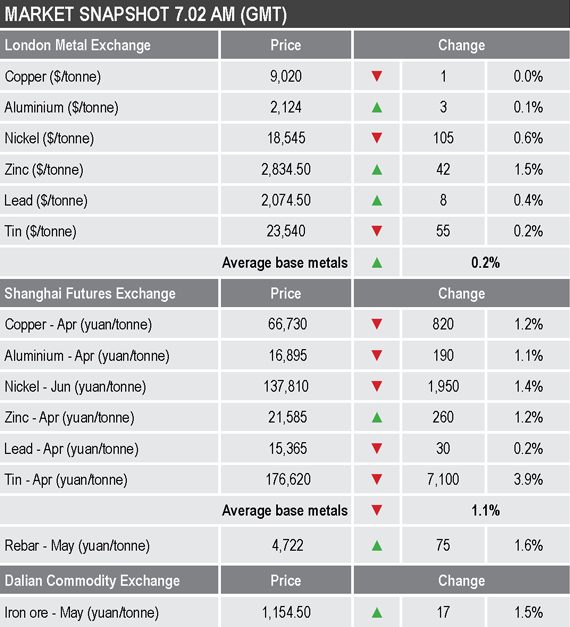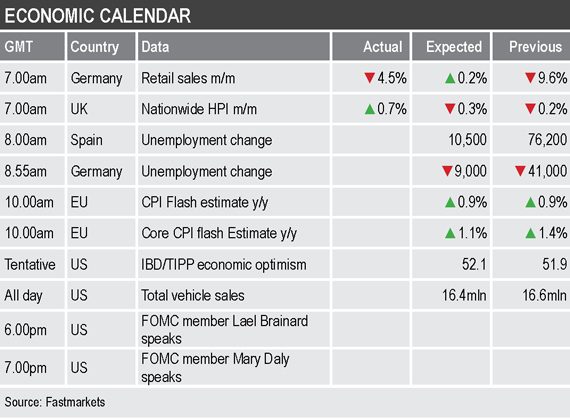Manufacturing, as indicated by recent purchasing managers index data, has provided mixed signals – growth is slowing in China, but still recovering well in Europe and the United States
Base metals
LME three-month base metals prices were mixed this morning, this after a mixed performance on Monday. This morning, nickel ($18,545 per tonne) and tin ($23,540 per tonne) were lower by 0.6% and 0.2% respectively, copper ($9,020 per tonne) was little changed, while the rest were firmer, led by a 1.5% rise in zinc ($2,834.50 per tonne), with lead up by 0.4% at ($2,074.50 per tonne) and aluminium ($2,124 per tonne) was little changed.
LME volume as of 7.02am London time was high at 15,381 lots – volume has been high since Chinese participants returned from the Lunar New Year holiday (February 11-17).
The most-traded base metals contracts on the SHFE were mainly weaker this morning, the exception was April zinc that was up by 1.2%, while the rest were down by an average of 1.6%.
Precious metals
Spot gold ($1,719.93 per oz) was down by 0.3%, silver ($26.20 per tonne) and platinum ($1,180.50 per oz) were down by 1.1% and 0.8% respectively, while palladium ($2,356.90 per oz) bucked the trend with a 0.2% gain.
Wider markets
The yield on US 10-year treasuries has pulled back in recent days and that has boosted risk-on appetite. It was recently quoted at 1.41%, down from last week’s high of 1.61%.
Asian-Pacific equities were mainly weaker this morning: the Hang Seng (-1.2%), the ASX 200 (-0.4%), the CSI 300 (-1.28%) and the Nikkei (-0.86%), while the Kospi (+1.03%) was bucking the trend.
Currencies
The US Dollar Index continues its climb and was recently quoted at 91.31, this after a low at 89.68 on February 25.
The other major currencies were weaker: the euro (1.2004), the Australian dollar (0.7744), sterling (1.3876) and the yen (106.81).
Key data
Data already out on Tuesday showed German retail sales fell by 4.5% month on month in January, this after a 9.6% fall in December. The United Kingdom’s house price index by climbed 0.7% month on month in February, after a 0.2% fall in January.
Later there is data on unemployment in Spain and Germany and European Union consumer prices, with US data on economic optimism and total vehicle sales.
In addition, US Federal Open Market Committee members Lael Brainard and Mary Daly are scheduled to speak.
Today’s key themes and views
After recent strength the base metals are pulling back to consolidate – we have for some time been on the lookout for a pause/pullback, given the metals have already done a lot on the upside, and this now seems to be underway. This correction should also let us see how strong underlying demand really is by seeing how far prices pull back and how long they pull back for. In the short term, the stronger US dollar is likely to be a headwind.
Gold prices have broken lower, below the November 2020 low at $1,765.50 per oz, extending the downward channel off last August’s high at $2,074.25 per oz. The recent run-up in bond yields has increased to opportunity cost of holding gold. But a cheaper gold price will make for a cheaper safe-haven should broader markets start to correct more.









